Distribution and Structure Analysis of Mountain Permafrost Landscape in Orulgan Ridge (Northeast Siberia) Using Google Earth Engine
Abstract
:1. Introduction
2. Background
3. Methodology and Materials
3.1. Study Region
3.2. Permafrost Landscape Mapping Approach
3.3. Methodology Workflow
3.4. Vegetation Cover Classification
3.5. GIS Terrain Analysis
3.6. Landscape Mapping and Data Synthesis
4. Results and Discussion
4.1. Comparison with Earlier Permafrost Landscape Mapping
4.2. Analysis of Topographic Landscape Variability of Orulgan Ridge
5. Conclusions
Author Contributions
Funding
Institutional Review Board Statement
Informed Consent Statement
Data Availability Statement
Acknowledgments
Conflicts of Interest
References
- Chernykh, D.; Bulatov, V. Mountain Landscapes: Space Arrangement and Ecological Peculiarities: Analyt; Review; IVEP SB RAS Sci. ed.; Plyusnin, V.M., Ed.; State Public lib.Sci.Tech.: Novosibirsk, Russia, 2002. [Google Scholar]
- Doblas-Reyes, F.J.; Sörensson, A.A.; Almazroui, M.; Dosio, A.; Gutowski, W.J.; Haarsma, R.; Hamdi, R.; Hewitson, B.; Kwon, W.-T.; Lamptey, B.; et al. Linking global to regional Climate Change. In Climate Change 2021: The Physical Science Basis. Contribution of working group I to the Sixth Assessment Report of the Intergovernmental Panel on Climate Change; Cambridge University Press: Cambridge, UK; New York, NY, USA, 2021. [Google Scholar]
- Haeberli, W.; Noetzli, J.; Arenson, L.; Delaloye, R.; Gärtner-Roer, I.; Gruber, S.; Isaksen, K.; Kneisel, C.; Krautblatter, M.; Phillips, M. Mountain permafrost: Development and challenges of a young research field. J. Glaciol. 2010, 56, 1043–1058. [Google Scholar] [CrossRef]
- Ponomarev, E.; Masyagina, O.; Litvintsev, K.; Ponomareva, T.; Shvetsov, E.; Finnikov, K. The Effect of Post-Fire Disturbances on a Seasonally Thawed Layer in the Permafrost Larch Forests of Central Siberia. Forests 2020, 11, 790. [Google Scholar] [CrossRef]
- Chen, Y.; Romps, D.M.; Seeley, J.T.; Veraverbeke, S.; Riley, W.J.; Mekonnen, Z.A.; Randerson, J.T. Future increases in Arctic lightning and fire risk for permafrost carbon. Nat. Clim. Chang. 2021, 11, 404–410. [Google Scholar] [CrossRef]
- Liu, C.; Huang, H.; Sun, F. A Pixel-Based Vegetation Greenness Trend Analysis over the Russian Tundra with All Available Landsat Data from 1984 to 2018. Remote Sens. 2021, 13, 4933. [Google Scholar] [CrossRef]
- Fedorov, A.N. Permafrost Landscapes: Classification and Mapping. Geosciences 2019, 9, 468. [Google Scholar] [CrossRef]
- Ravolainen, V.; Soininen, E.M.; Jónsdóttir, I.S.; Eischeid, I.; Forchhammer, M.; van der Wal, R.; Pedersen, Å.Ø. High Arctic ecosystem states: Conceptual models of vegetation change to guide long-term monitoring and research. Ambio 2020, 49, 666–677. [Google Scholar] [CrossRef]
- Bobylev, N.G.; Gadal, S.; Konovalova, M.O.; Sergunin, A.A.; Tronin, A.A.; Tynkkynen, V.-P. Regional Ranking of the Arctic Zone of the Russian Federationon the Basis of the Environmental Security Index. North Mark. Form. Econ. Order 2020, 69, 17–40. [Google Scholar] [CrossRef]
- Angelstam, P.; Elbakidze, M.; Axelsson, R.; Khoroshev, A.; Pedroli, B.; Tysiachniouk, M.; Zabubenin, E. Model forests in Russia as landscape approach: Demonstration projects or initiatives for learning towards sustainable forest management? For. Policy Econ. 2019, 101, 96–110. [Google Scholar] [CrossRef]
- Hitztaler, S.K.; Bergen, K.M. Mapping resource use over a Russian landscape: An integrated look at harvesting of a non-timber forest product in central Kamchatka. Environ. Res. Lett. 2013, 8, 045020. [Google Scholar] [CrossRef]
- Marinskikh, D.; Marshinin, A.; Idrisov, I. Large-scale Landscape Mapping for Environmental Risk Assessment in the Arctic of Western Siberia (Russia). GI_Forum 2017, 1, 3–14. [Google Scholar] [CrossRef]
- Fedorov, A.N.; Botulu, T.A.; Varlamov, S.P.; Vasiliev, I.S.; Gribanova, S.P.; Dorofeev, I.V.; Klimovsky, I.V.; Samsonova, V.V.; Soloviev, P.A. Permafrost landscapes in Yakutia. In Explanation Note to the Permafrost-Landscape Map of the Yakut ASSR at a 1:2,500,000 Scale; GUGK: Novosibirsk, Russia, 1989. (In Russian) [Google Scholar]
- Cullum, C.; Rogers, K.H.; Brierley, G.; Witkowski, E.T. Ecological classification and mapping for landscape management and science Foundations for the description of patterns and processes. Prog. Phys. Geogr. Earth Environ. 2015, 40, 38–65. [Google Scholar] [CrossRef]
- Fedorov, A.N.; Botulu, T.A.; Vasiliev, I.S.; Varlamov, S.P.; Gribanova, S.P.; Dorofeev, I.V. Permafrost-Landscape Map of the Yakut ASSR, Scale 1:2,500,000, 2 Sheets; Melnikov, P.I., Ed.; Gosgeodezia: Moscow, Russia, 1991. [Google Scholar]
- Fedorov, A.N. Permafrost Landscape research in the Northeast of Eurasia. Earth 2022, 3, 28. [Google Scholar] [CrossRef]
- Fedorov, A.N.; Vasilyev, N.F.; Torgovkin, Y.I.; Shestakova, A.A.; Varlamov, S.P.; Zheleznyak, M.N.; Shepelev, V.V.; Konstantinov, P.Y.; Kalinicheva, S.S.; Basharin, N.I.; et al. Permafrost-Landscape Map of the Republic of Sakha (Yakutia) on a Scale 1:1,500,000. Geosciences 2018, 8, 465. [Google Scholar] [CrossRef]
- Milkov, F.N. Landscape Geography and Practice Questions; Mysl: Moscow, Russia, 1966. (In Russian) [Google Scholar]
- Sochava, V.B. Introduction to the Study of Geosystems; Nauka: Novosibirsk, Russia, 1978. (In Russian) [Google Scholar]
- García-Llamas, P.; Calvo, L.; Álvarez-Martínez, J.M.; Suárez-Seoane, S. Using remote sensing products to classify landscape. A multi-spatial resolution approach. Int. J. Appl. Earth Obs. Geoinf. ITC J. 2016, 50, 95–105. [Google Scholar] [CrossRef]
- Jorgenson, M.T.; Osterkamp, T.E. Response of boreal ecosystems to varying modes of permafrost degradation. Can. J. For. Res. 2005, 35, 2100–2111. [Google Scholar] [CrossRef]
- Erikstad, L.; Uttakleiv, L.A.; Halvorsen, R. Characterisation and mapping of landscape types, a case study from Norway. Belgeo 2015, 3, 15. [Google Scholar] [CrossRef]
- Simensen, T.; Erikstad, L.; Halvorsen, R. Diversity and distribution of landscape types in Norway. Nor. Geogr. Tidsskr.-Nor. J. Geogr. 2021, 75, 79–100. [Google Scholar] [CrossRef]
- Newton, A.C.; Hill, R.A.; Echeverría, C.; Golicher, D.; Benayas, J.M.R.; Cayuela, L.; Hinsley, S.A. Remote sensing and the future of landscape ecology. Prog. Phys. Geogr. Earth Environ. 2009, 33, 528–546. [Google Scholar] [CrossRef]
- Bartalev, S.A.; Egorov, V.A.; Ershov, D.V.; Isaev, A.S.; Lupyan, E.A.; Plotnikov, D.E.; Uvarov, I.A. Mapping of Russian’s vegetation cover using MODIS satellite spectroradiometer data. Sovrem. Probl. Distantsionnogo Zondirovaniya Zemli Iz Kosm. 2011, 8, 285–302. (In Russian) [Google Scholar]
- Shasby, M.; Carneggie, D.M. Vegetation and terrain mapping in Alaska using Landsat MSS and Digital terrain data. Photogr. Eng. Remote Sens. 1986, 52, 779–786. [Google Scholar]
- Belgiu, M.; Csillik, O. Sentinel-2 cropland mapping using pixel-based and object-based time-weighted dynamic time warping analysis. Remote Sens. Environ. 2018, 204, 509–523. [Google Scholar] [CrossRef]
- Müller, H.; Rufin, P.; Griffiths, P.; Barros Siqueira, A.J.; Hostert, P. Mining dense Landsat time series for separating cropland and pasture in a heterogeneous Brazilian savanna landscape. Remote Sens. Environ. 2015, 156, 490–499. [Google Scholar] [CrossRef]
- Xu, R.; Zhao, S.; Ke, Y. A Simple Phenology-Based Vegetation Index for Mapping Invasive Spartina Alterniflora Using Google Earth Engine. IEEE J. Sel. Top. Appl. Earth Obs. Remote Sens. 2020, 14, 190–201. [Google Scholar] [CrossRef]
- Liu, X.; Liu, H.; Datta, P.; Frey, J.; Koch, B. Mapping an Invasive Plant Spartina alterniflora by Combining an Ensemble One-Class Classification Algorithm with a Phenological NDVI Time-Series Analysis Approach in Middle Coast of Jiangsu, China. Remote Sens. 2020, 12, 4010. [Google Scholar] [CrossRef]
- Jahromi, M.N.; Jahromi, M.N.; Zolghadr-Asli, B.; Pourghasemi, H.R.; Alavipanah, S.K. Google Earth Engine and Its Application in Forest Sciences. In Spatial Modeling in Forest Resources Management; Springer: Berlin/Heidelberg, Germany, 2020; pp. 629–649. [Google Scholar] [CrossRef]
- Liu, Z.; Liu, H.; Luo, C.; Yang, H.; Meng, X.; Ju, Y.; Guo, D. Rapid Extraction of Regional-scale Agricultural Disasters by the Standardized Monitoring Model Based on Google Earth Engine. Sustainability 2020, 12, 6497. [Google Scholar] [CrossRef]
- DeLancey, E.R.; Kariyeva, J.; Bried, J.T.; Hird, J. Large-scale probabilistic identification of boreal peatlands using Google Earth Engine, open-access satellite data, and machine learning. PLoS ONE 2019, 14, e0218165. [Google Scholar] [CrossRef]
- Suleymanov, A.; Abakumov, E.; Suleymanov, R.; Gabbasova, I.; Komissarov, M. The Soil Nutrient Digital Mapping for Precision Agriculture Cases in the Trans-Ural Steppe Zone of Russia Using Topographic Attributes. ISPRS Int. J. Geo-Inf. 2021, 10, 243. [Google Scholar] [CrossRef]
- Jorgenson, M.T.; Frost, G.V.; Dissing, D. Drivers of Landscape Changes in Coastal Ecosystems on the Yukon-Kuskokwim Delta, Alaska. Remote Sens. 2018, 10, 1280. [Google Scholar] [CrossRef]
- Kalinicheva, S.V.; Fedorov, A.N.; Zhelezniak, M.N. Mapping Mountain Permafrost Landscapes in Siberia Using Landsat Thermal Imagery. Geosciences 2018, 9, 4. [Google Scholar] [CrossRef]
- Shestakova, A.; Fedorov, A.; Torgovkin, Y.; Konstantinov, P.; Vasyliev, N.; Kalinicheva, S.; Samsonova, V.; Hiyama, T.; Iijima, Y.; Park, H.; et al. Mapping the Main Characteristics of Permafrost on the Basis of a Permafrost-Landscape Map of Yakutia Using GIS. Land 2021, 10, 462. [Google Scholar] [CrossRef]
- Zakharov, M.; Gadal, S.; Danilov, Y.; Kamičaitytė, J. Mapping Siberian Arctic Mountain Permafrost Landscapes by Machine Learning Multi-sensors Remote Sensing: Example of Adycha River Valley. In Proceedings of the 7th International Conference on Geographical Information Systems Theory, Applications and Management (GISTAM 2021); INSTICC, Online, 23–25 April 2021; pp. 125–133. [Google Scholar] [CrossRef]
- Zakharov, M.; Cherosov, M.; Troeva, E.; Gadal, S. Vegetation cover analysis of the mountainous part of north-eastern Siberia by means of geoinformation modelling and machine learning (basic principles, approaches, technology and relation to geosystem science). BIO Web Conf. 2021, 38, 00142. [Google Scholar] [CrossRef]
- Fondahl, G.; Filippova, V.; Savvinova, A.; Ivanova, A.; Stammler, F.; Gjørv, G.H. Niches of agency: Managing state-region relations through law in Russia. Space Polity 2019, 23, 49–66. [Google Scholar] [CrossRef]
- Fridosky, V. Structures of early-collision gold ore deposits of the Verkhoyansk fold-and-thrust belt. Ore Geol. Rev. 1997, 103, 1109–1126. [Google Scholar]
- Amani, M.; Ghorbanian, A.; Ahmadi, S.A.; Kakooei, M.; Moghimi, A.; Mirmazloumi, S.M.; Moghaddam, S.H.A.; Mahdavi, S.; Ghahremanloo, M.; Parsian, S.; et al. Google Earth Engine Cloud Computing Platform for Remote Sensing Big Data Applications: A Comprehensive Review. IEEE J. Sel. Top. Appl. Earth Obs. Remote Sens. 2020, 13, 5326–5350. [Google Scholar] [CrossRef]
- Zakharov, M.; Danilov, Y.; Gadal, S.; Troeva, E.; Cherosov, M. Landscape Structure Analysis of the Orulgan Ridge Eastern Slope. Uspekhi Sovrem. Yestestvoznaniya 2022, 3, 49–55. [Google Scholar] [CrossRef]
- Hillebrand, H.; Bennett, D.M.; Cadotte, M.W. Consequences of Dominance: A Review of Evenness Effects on Local and Regional Ecosystem Processes. Ecology 2008, 89, 1510–1520. [Google Scholar] [CrossRef]
- Jennings, M.D.; Faber-Langendoen, N.; Loucks, O.L.; Peet, R.K.; Roberts, D. Standards for associations and alliances of the U.S. National Vegetation Classification. Ecol. Monogr. 2009, 79, 173–199. [Google Scholar] [CrossRef]
- Brewer, C.K.; Goetz, W.; Lister, A.J.; Megown, K.; Riley, M.; Maus, P. Existing Vegetation Classification, Mapping, and Inventory Technical Guide Version 2.0. United States Dep. For. Serv. Agric. Gen. Tech. Rep. WO-90. 2015. Available online: https://www.fs.fed.us/emc/rig/documents/protocols/vegClassMapInv/EVTG_v2-0_June2015.pdf (accessed on 10 January 2022).
- Pau, S.; Dee, L.E. Remote sensing of species dominance and the value for quantifying ecosystem services. Remote Sens. Ecol. Conserv. 2016, 2, 141–151. [Google Scholar] [CrossRef]
- Riihimäki, H.; Luoto, M.; Heiskanen, J. Estimating fractional cover of tundra vegetation at multiple scales using unmanned aerial systems and optical satellite data. Remote Sens. Environ. 2019, 224, 119–132. [Google Scholar] [CrossRef]
- Gitelson, A.A.; Kaufman, Y.J.; Merzlyak, M.N. Use of a green channel in remote sensing of global vegetation from EOS-MODIS. Remote Sens. Environ. 1996, 58, 289–298. [Google Scholar] [CrossRef]
- Nikolin, E.G.; Troeva, E.I. A map of botanical zoning of Verkhoyanskii Ridge, in Mater. In Vseross. Konf. “Otechestvennaya Geobotanika: Osnovnye Vekhi i Perspektivy” (Proc. All-Russ. Conf. “National Geobotany: Important Historical Steps and Prospects”); Boston-Spektr: St. Petersburg, Russia, 2011; Volume 1, pp. 379–381. [Google Scholar]
- Kuvaev, V. The Flora of Subarctic Mountains in Eurasia and Altitudinal Distribution of Its Species; KMK Scientific Press Ltd.: Moscow, Russia, 2006; pp. 35–38. (In Russian) [Google Scholar]
- Elovskaya, L.G.; Petrova, E.I.; Teterina, L.V.; Naumov, E.M. Soil map. In Agricultural Atlas of Yakutian ASSR; GUGK: Moscow, Russia, 1989; pp. 40–41. (In Russian) [Google Scholar]
- Tomaselli, V.; Adamo, M.; Veronico, G.; Sciandrello, S.; Tarantino, C.; Dimopoulos, P.; Medagli, P.; Nagendra, H.; Blonda, P. Definition and application of expert knowledge on vegetation pattern, phenology, and seasonality for habitat mapping, as exemplified in a Mediterranean coastal site. Off. J. Soc. Bot. Ital. 2016, 151, 887–899. [Google Scholar] [CrossRef]
- Burges, C.J.C. A Tutorial on Support Vector Machines for Pattern Recognition. Data Min. Knowl. Discov. 1998, 2, 121–167. [Google Scholar] [CrossRef]
- Stehman, S.V. Selecting and interpreting measures of thematic classification accuracy. Remote Sens. Environ. 1997, 62, 77–89. [Google Scholar] [CrossRef]
- Shi, D.; Yang, X. Support Vector Machines for Land Cover Mapping from Remote Sensor Imagery. In Monitoring and Modeling of Global Changes: A Geomatics Perspective; Springer: Berlin/Heidelberg, Germany, 2015; pp. 265–279. [Google Scholar] [CrossRef]
- Chernykh, D.V.; Biryukov, R.Y.; Zolotov, D.V.; Pershin, D.K. Spatiotemporal Dynamics of Landscapes of Plain and Mountain Catchments in the Altai Region During the Last 40 Years. Geogr. Nat. Resour. 2018, 39, 228–238. [Google Scholar] [CrossRef]
- Jenness, J. Topographic Position Index (tpi_jen.avx) Extension for ArcView 3.x, v. 1.3a. Jenness Enterprises. 2006. Available online: http://www.jennessent.com/arcview/tpi.html (accessed on 10 January 2022).
- Vosselman, G. Slope based filtering of laser altimetry data. Int. Arch. Photogramm. Remote Sens. 2000, 23, 935–942. [Google Scholar]
- Weiss, A. Topographic position and landforms analysis. In Poster Presentation, ESRI User Conference, San Diego, CA. 2001. Available online: http://www.jennessent.com/downloads/TPI-poster-TNC_18x22.pdf (accessed on 10 January 2022).
- Medvedkov, A.A. Mapping of Permafrost Landscapes Based on the Analysis of Termal Images. Proc. Int. Conf. InterCarto. InterGIS 2016, 1, 380–384. [Google Scholar] [CrossRef]
- Simensen, T.; Halvorsen, R.; Erikstad, L. Methods for landscape characterisation and mapping: A systematic review. Land Use Policy 2018, 75, 557–569. [Google Scholar] [CrossRef]
- Nikolin, E.G. Flora of a valley complex of the Verkhoyansk Range (North-eastern Asia). In Comparative Floristics: Analysis of Plant Species Diversity. Prob. Perspect. Proceed.; Baranova, O.G., Litvinskaya, S.A., Eds.; Kuban State University: Krasnodar, Russia, 2014; pp. 84–95. (In Russian) [Google Scholar]
- Lytkin, V. Inventory and Distribution of Rock Glaciers in Northeastern Yakutia. Land 2020, 9, 384. [Google Scholar] [CrossRef]
- Talucci, A.; Forbath, E.; Kropp, H.; Alexander, H.; DeMarco, J.; Paulson, A.; Zimov, N.; Zimov, S.; Loranty, M. Evaluating Post-Fire Vegetation Recovery in Cajander Larch Forests in Northeastern Siberia Using UAV Derived Vegetation Indices. Remote Sens. 2020, 12, 2970. [Google Scholar] [CrossRef]
- Jorgenson, J.C.; Hoef, J.M.V.; Jorgenson, M.T. Long-term recovery patterns of arctic tundra after winter seismic exploration. Ecol. Appl. Publ. Ecol. Soc. Am. 2010, 20, 205–221. [Google Scholar] [CrossRef] [PubMed]
- Vincent, W.F.; Lemay, M.; Allard, M. Arctic permafrost landscapes in transition: Towards an integrated Earth system approach. Arct. Sci. 2017, 3, 39–64. [Google Scholar] [CrossRef]
- Holloway, J.E.; Lewkowicz, A.G.; Douglas, T.A.; Li, X.; Turetsky, M.R.; Baltzer, J.L.; Jin, H. Impact of wildfire on permafrost landscapes: A review of recent advances and future prospects. Permafr. Periglac. Process. 2020, 31, 371–382. [Google Scholar] [CrossRef]
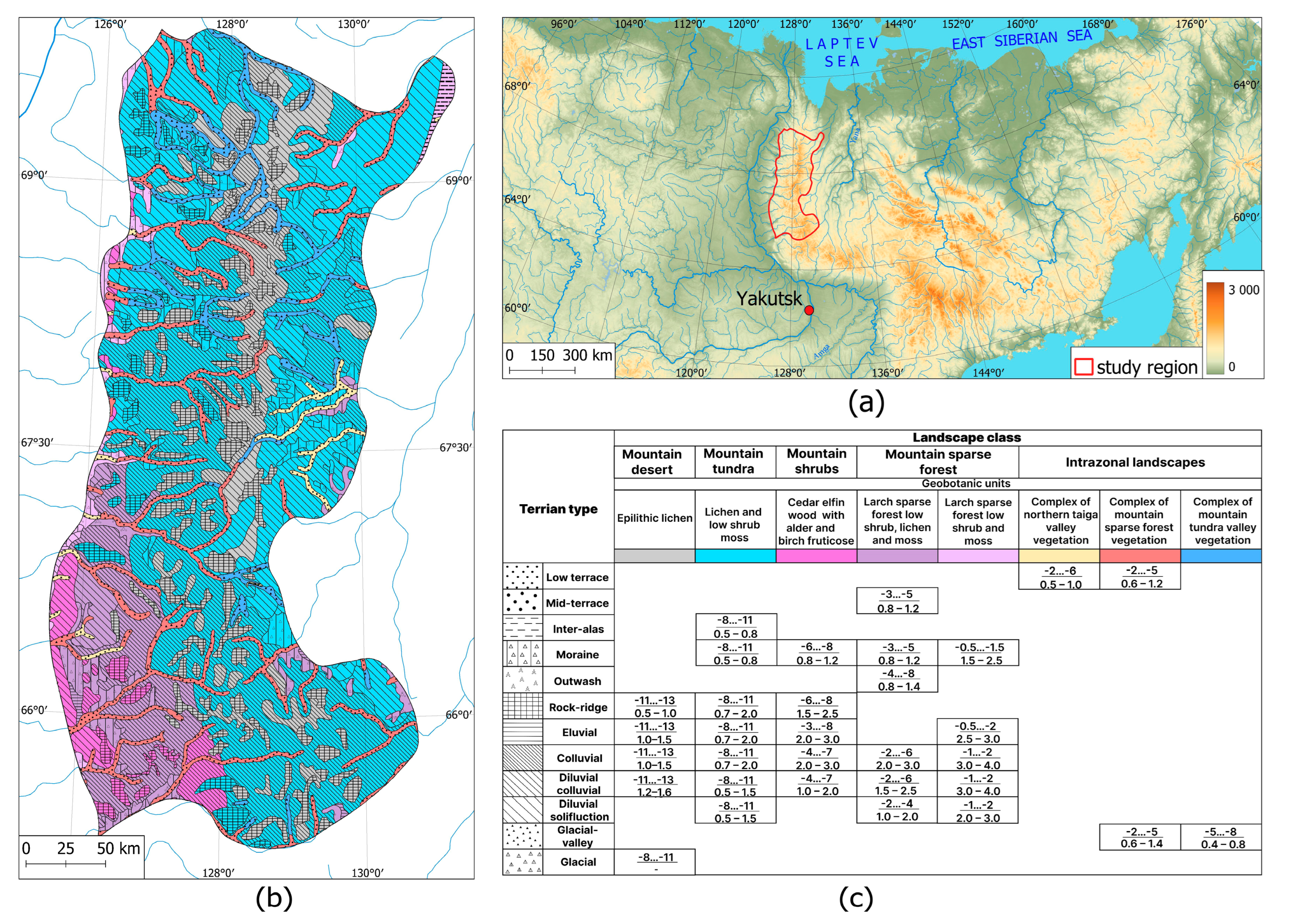

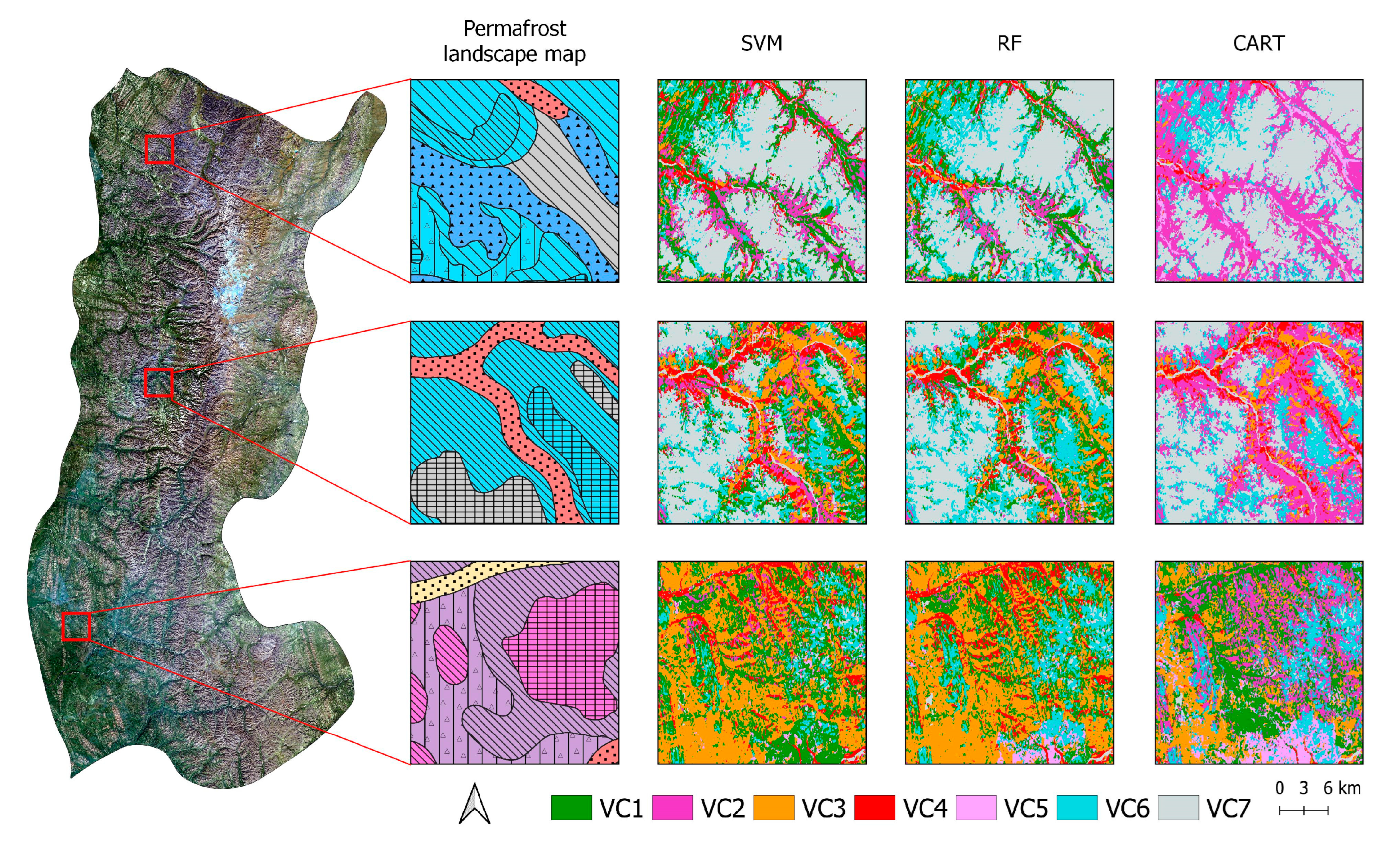
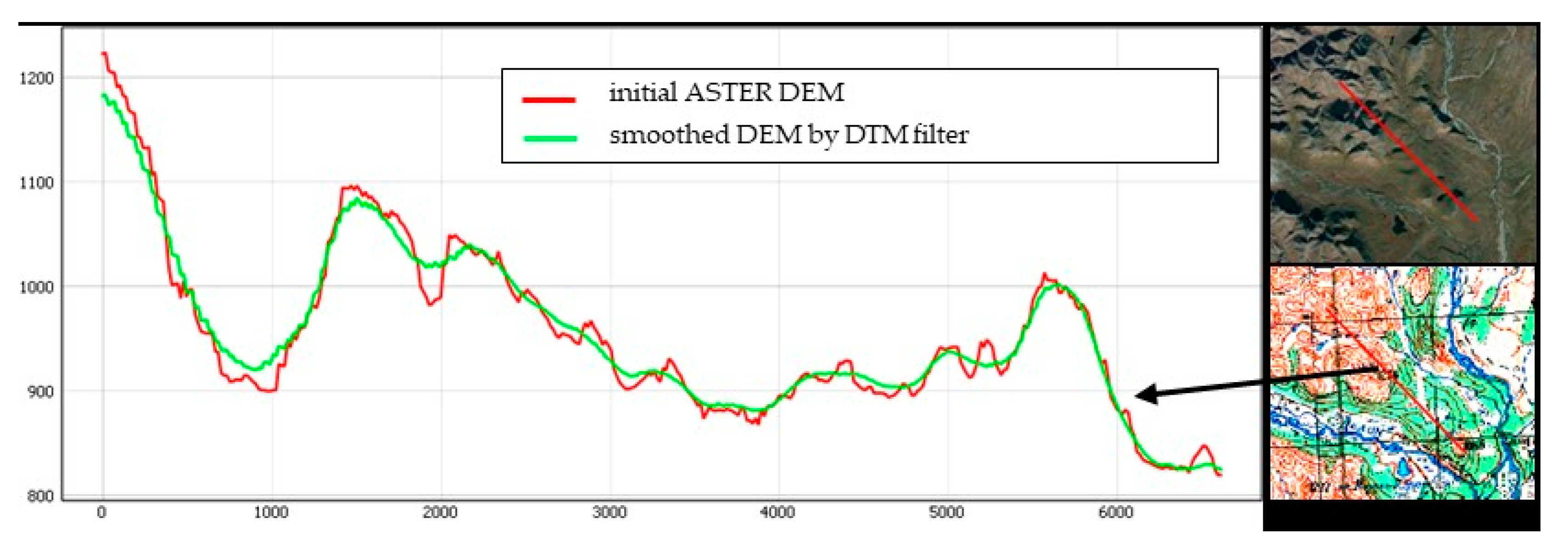
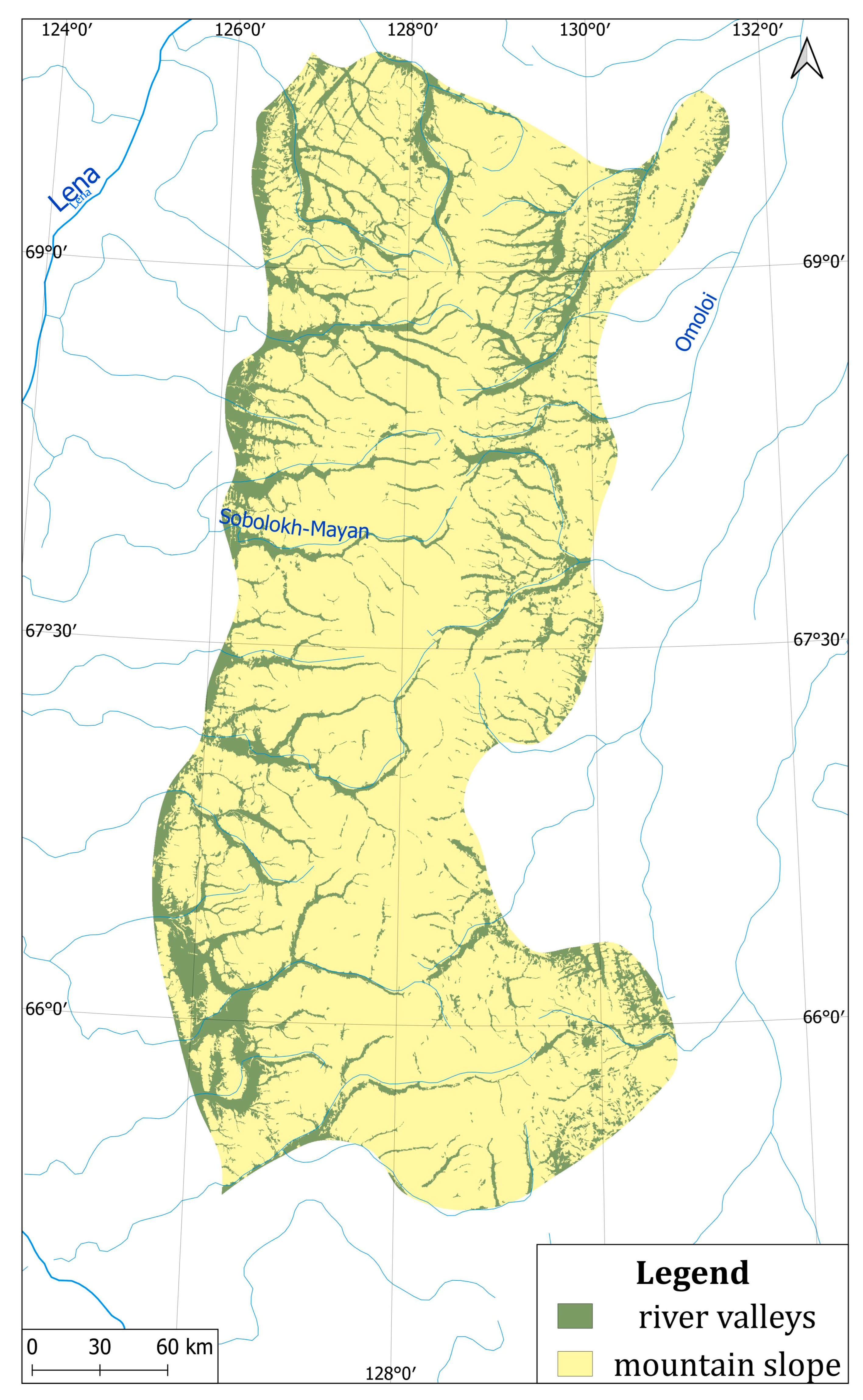
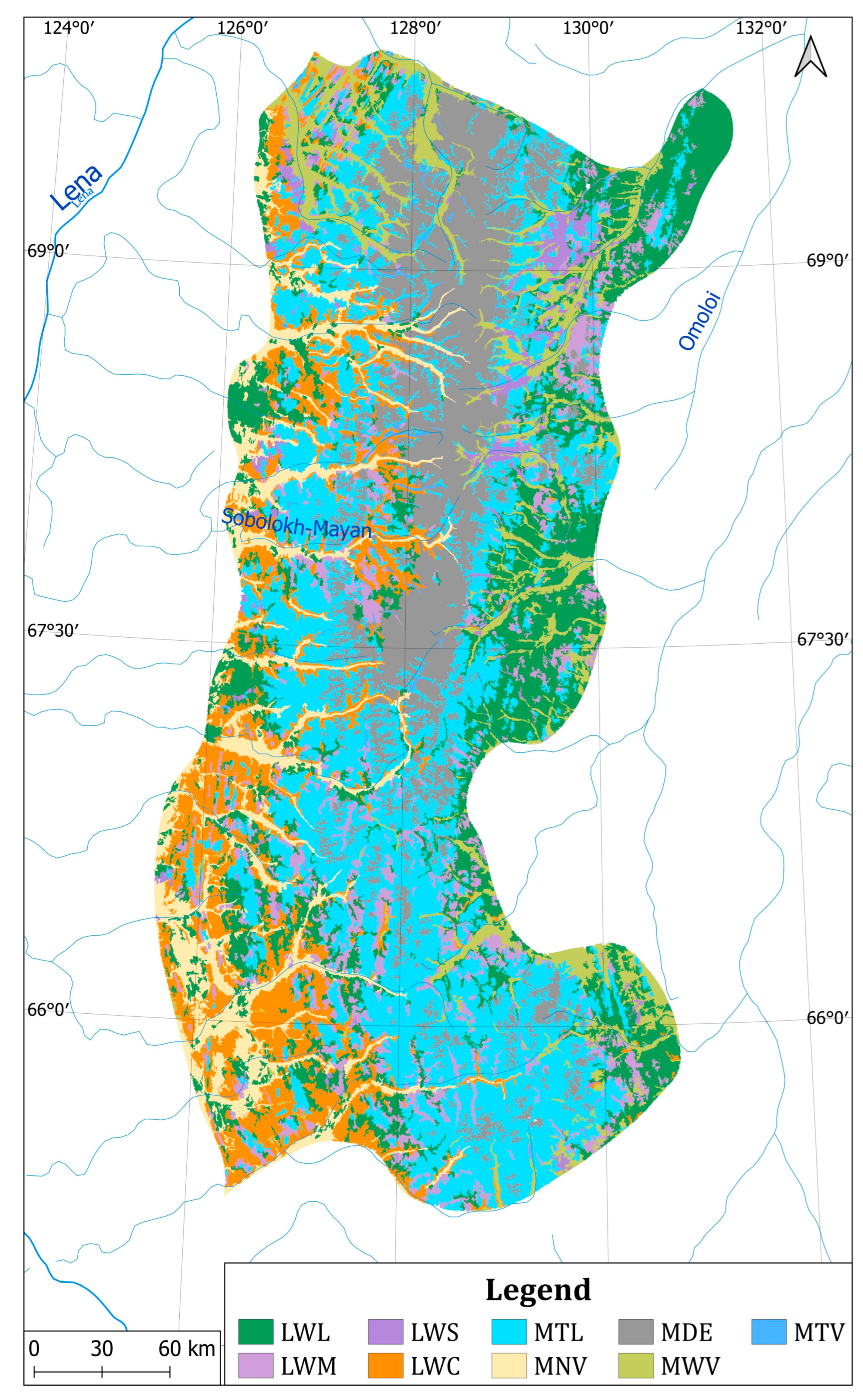
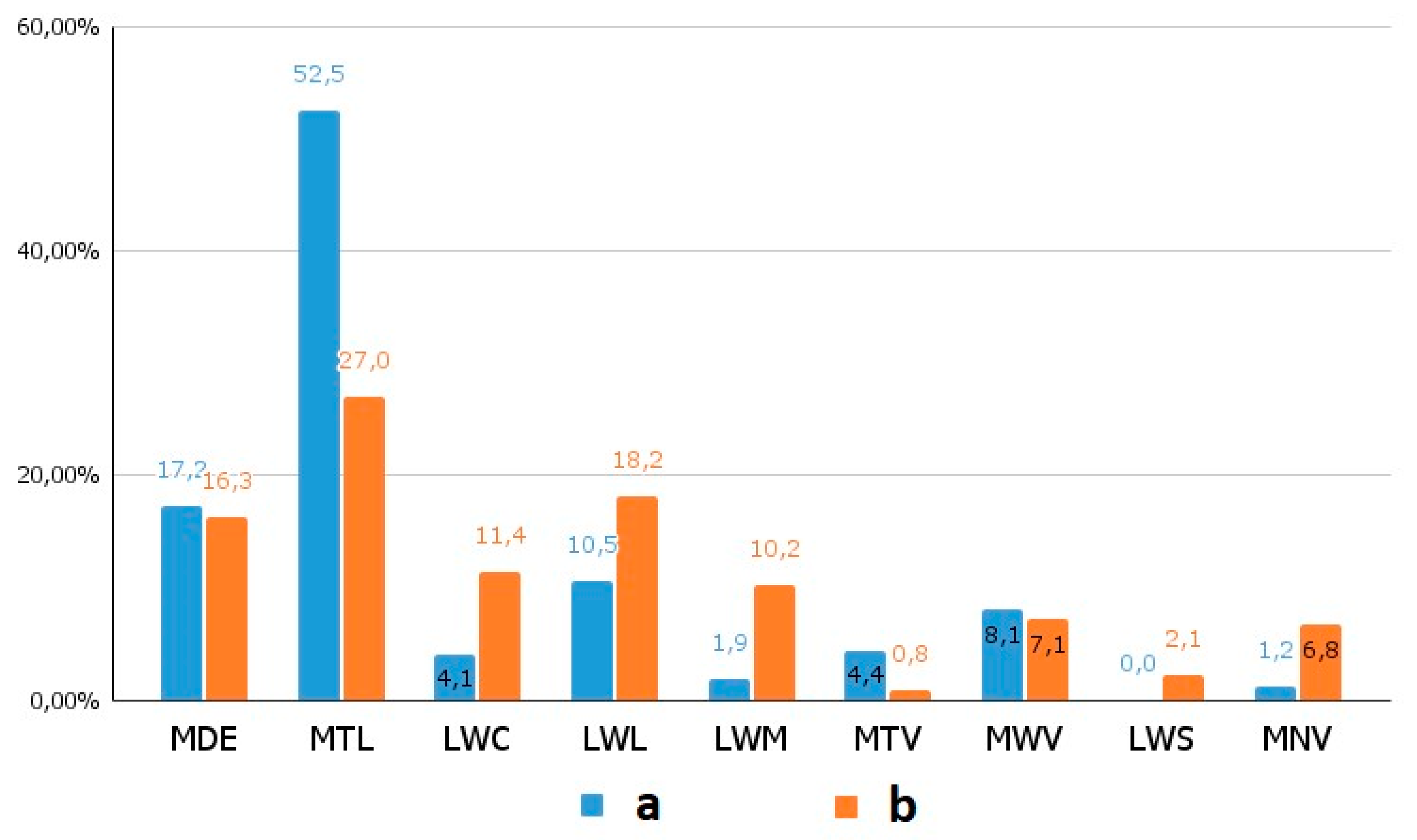
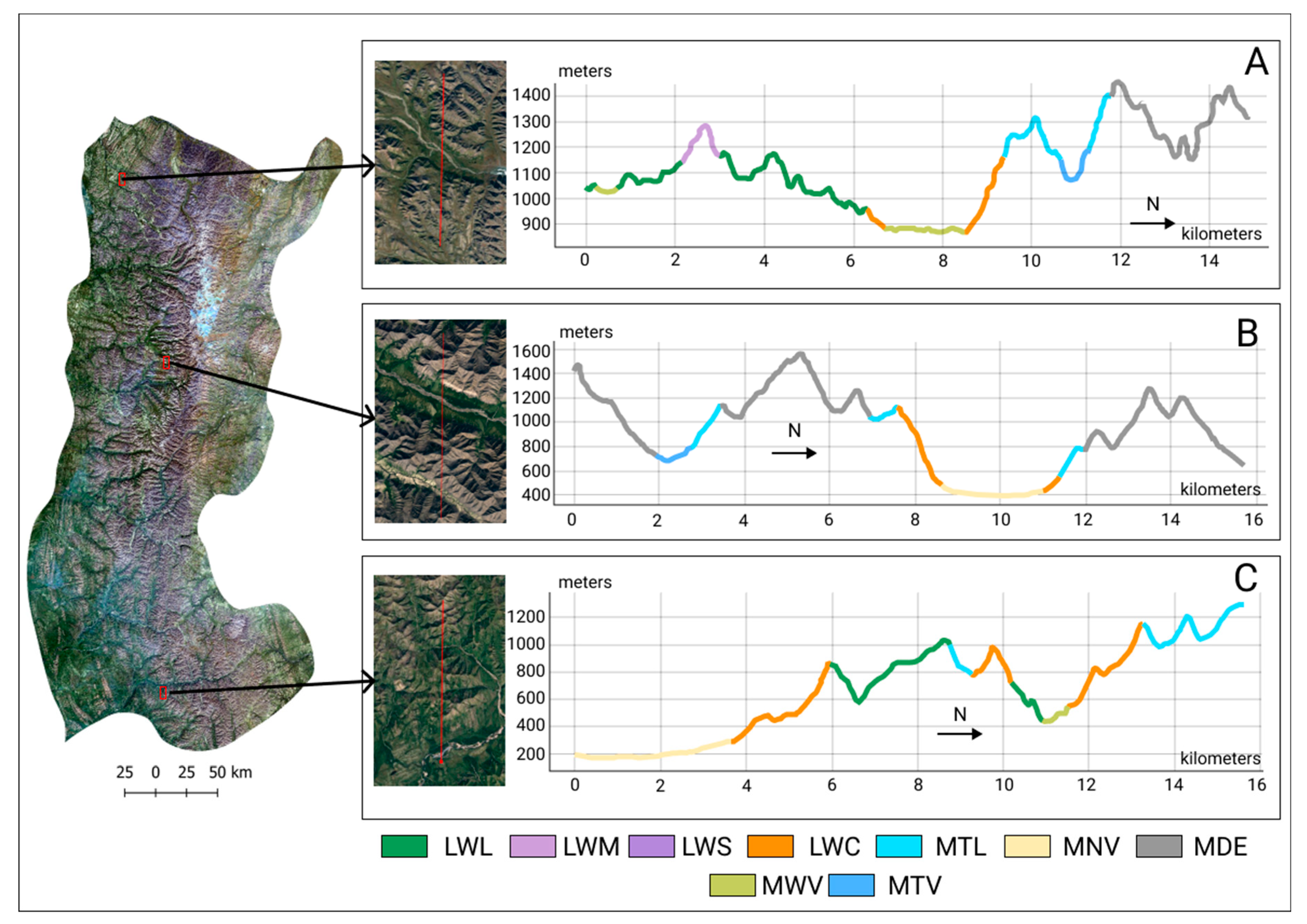
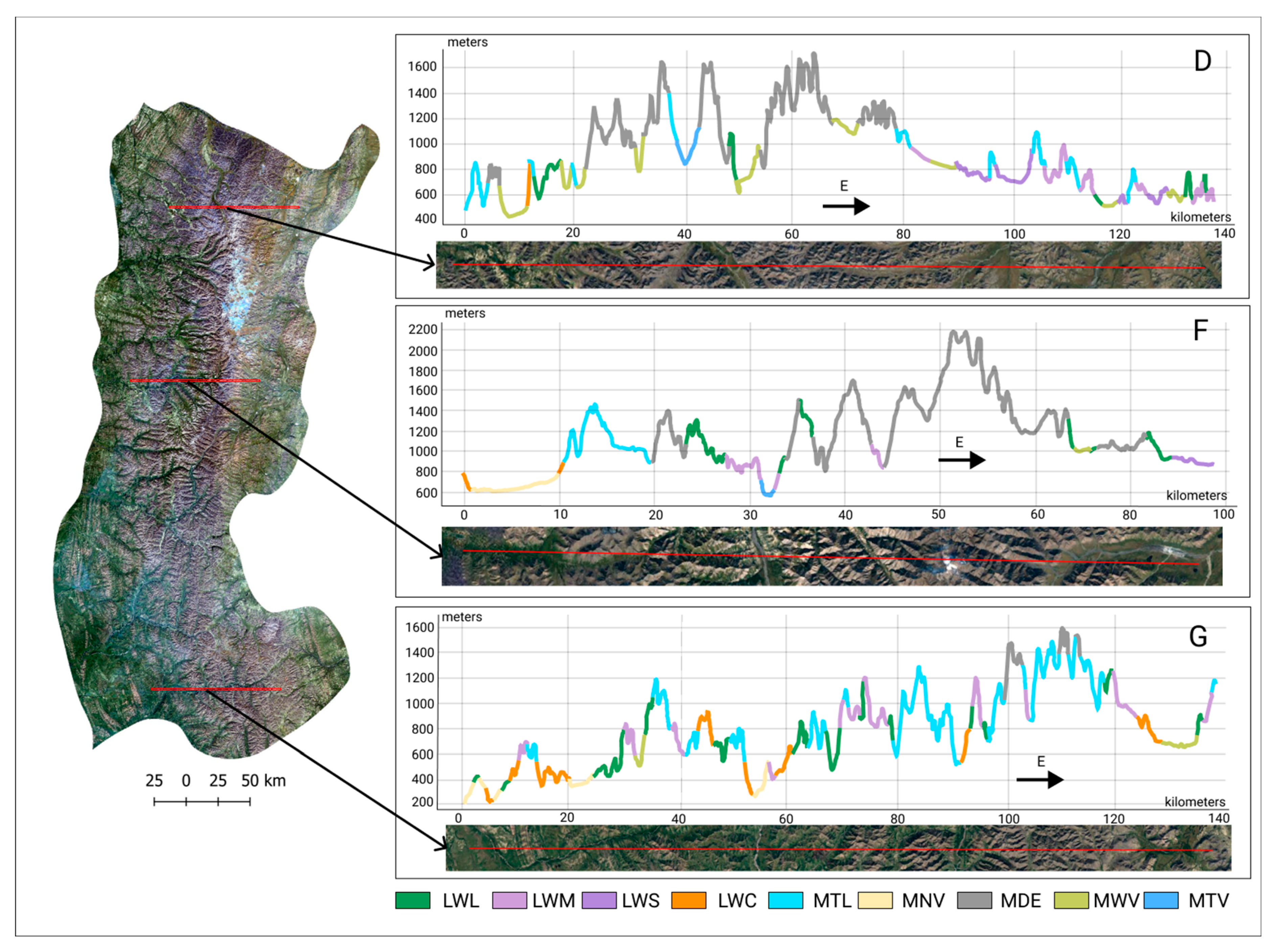
| Classification Categories | Geobotanical Units | Landforms | Lythology | Approximate Coverage, km2 |
|---|---|---|---|---|
| Class of landscape | combination of vegetation associations and formations | megarelief | - | >500 |
| Type of terrian | - | mezorelief | Quaternary deposits | 50–500 |
| Type of landscape | group of vegetation associations | mezorelief | Quaternary deposits | <50 |
| Date | Sentinel 2 All Data | Landsat 8 OLI All Data | Sentinel 2 Cloud-Free Data | Landsat 8 OLI Cloud-Free Data |
|---|---|---|---|---|
| Early September | 610 | 293 | 124 | 48 |
| August | 909 | 423 | 138 | 68 |
| July | 921 | 368 | 210 | 75 |
| Late June | 448 | 165 | 78 | 32 |
| Total | 2888 | 1249 | 550 | 223 |
| Code | Geobotanical Units | Training Samples | Validation Samples |
|---|---|---|---|
| VC1 | Larix sparse forests with low shrubs, lichen and green moss | 58 | 95 |
| VC2 | Larix sparse forests with lichen and green moss | 34 | 90 |
| VC3 | Larix sparse forests with low shrub—Lichen and Pinus pumila in combination with Duschekia fruticosa shrubs | 56 | 85 |
| VC4 | Alder and willows with areas of Larix, Populus and Chozenia forest | 65 | 115 |
| VC5 | Larix sparse forest with bogs | 56 | 120 |
| VC6 | Lichen and low shrub | 23 | 120 |
| VC7 | Epilithic lichens and non-vegetation cover | 34 | 110 |
| Total | 326 | 735 |
| Vegetation Classes | SVM | RF | CART | |||
|---|---|---|---|---|---|---|
| PA, % | UA, % | PA, % | UA, % | PA, % | UA, % | |
| VC1 | 90 | 88 | 77 | 82 | 67 | 78 |
| VC2 | 88 | 83 | 87 | 82 | 74 | 83 |
| VC3 | 85 | 82 | 79 | 79 | 68 | 77 |
| VC4 | 83 | 85 | 82 | 78 | 77 | 55 |
| VC5 | 88 | 88 | 82 | 84 | 73 | 74 |
| VC6 | 74 | 76 | 70 | 71 | 68 | 68 |
| VC7 | 79 | 84 | 76 | 79 | 79 | 61 |
| Overall accuracy, % | 85.4 | 78.5 | 70.8 | |||
| Kappa coefficient | 0.74 | 0.61 | 0.47 | |||
| Permafrost Landscape Class | Code | Description |
|---|---|---|
| Mountain desert | MDE | Landscape of the arctic deserts. Vegetation is sporadic or absent. Lichen (Rhizocarpon geographicum, Haematomma ventosum, Umbilicaria). Mountain peaks and steep mountain slopes. |
| Mountain tundra | MTL | Landscape of the arctic tundra. Lichens (Alectoria ochroleuca, Coelocaulon divergens), low shrubs (Dryas punctata, Cassiope tetragona). Steep near-summit slopes, mountain top surfaces, slopes of the northern or eastern exposure. |
| Sparse Larix forests, low shrub, lichen and moss | LWL | The most common class of Larix sparse forest landscape. They are common on gentle slopes or at the foot of steep slopes. Low shrubs are represented by Ledum palustre, Vaccinium uliginosum, V. vitis-idaea. Lichens (Cetraria cucullata) mosses (Aulacomnium turgidum). |
| Sparse Larix forests, lichen and moss | LWM | Mountain Larix sparse forest landscape. Shrub cover is practically absent. Lichens (Cetraria cucullata), mosses (Aulacomnium turgidum). They are common on medium slopes and elevated sections of slopes. |
| Sparse Larix forest, sphagnum | LWS | Mountain Larix sparse forest landscape. The low shrub cover is represented by Vaccinium uliginosum, Chamaedaphne calyculata, mosses (Aulacomnium turgidum, Sphagnum warnstorffi, Sph. balticum). Lichens (Cetraria cucullata), mosses (Aulacomnium turgidum). It is characterized by high humidity and the presence of swamps at the foot of slopes and flat areas. |
| Sparse Larix forests, low shrub—Lichen with Pinus pumila | LWC | Mountain Larix sparse forest and mountain shrubs landscape. The difference of the class is the presence of shrub layer: Betula exilis, Pinus pumila. Low shrubs: Ledum palustre, Vaccinium uliginosum, lichens (Cetraria cucullata, Cladina arbuscula) mosses (Aulacomnium turgidum, Sphagnum spp.). They are common on the slopes of the southern and western exposures and the slopes of the valleys of the Lena River basin. |
| Boreal taiga in valley | MNV | Intrazonal boreal taiga landscape along river valleys. Vegetation is represented by many formations and associations. Horsetail (Equisetum arvense) green-moss (Aulacomnium turgidum, Hylocomium splendens) and sphagnum (Sphagnum balticum, Sph. fimbriatum) in combination with willow meadows and grass bogs. Mixed forests of green moss (Aulacomnium turgidum) type in combination with yernik (Betula fruticosa), grasses (Calamagrostis neglecta, Agrostis trinii), sedge (Carex stans, C. minuta, C. atherodes) and cotton-grass (Eriophorum polystachyon). They are distributed along the valleys of the Lena River basin. |
| Mountain forest in valley | MWV | Intrazonal mountain sparse forest landscape along river valleys. Larix forest with Ledum palustre, Vaccinium uliginosum, V. vitis-idaea with areas of chozenia (Chosenia arbutifolia) and poplar (Populus suaveolens) forests. Most of the landscapes belong to the valleys of the Yana River basin. |
| Mountain tundra in valley | MTV | Intrazonal mountain tundra landscape along trough valleys. Within the mountain tundra, river valleys are not developed properly. Complex tundra communities (Ledum palustre, Arctous alpina, Koenigia tripterocarpa, Andromeda polifolia, Empetrum nigrum) with sparse shrubs of Betula nana subsp. exilis represent transition between slope and riparian vegetation. |
Publisher’s Note: MDPI stays neutral with regard to jurisdictional claims in published maps and institutional affiliations. |
© 2022 by the authors. Licensee MDPI, Basel, Switzerland. This article is an open access article distributed under the terms and conditions of the Creative Commons Attribution (CC BY) license (https://creativecommons.org/licenses/by/4.0/).
Share and Cite
Zakharov, M.; Gadal, S.; Kamičaitytė, J.; Cherosov, M.; Troeva, E. Distribution and Structure Analysis of Mountain Permafrost Landscape in Orulgan Ridge (Northeast Siberia) Using Google Earth Engine. Land 2022, 11, 1187. https://doi.org/10.3390/land11081187
Zakharov M, Gadal S, Kamičaitytė J, Cherosov M, Troeva E. Distribution and Structure Analysis of Mountain Permafrost Landscape in Orulgan Ridge (Northeast Siberia) Using Google Earth Engine. Land. 2022; 11(8):1187. https://doi.org/10.3390/land11081187
Chicago/Turabian StyleZakharov, Moisei, Sébastien Gadal, Jūratė Kamičaitytė, Mikhail Cherosov, and Elena Troeva. 2022. "Distribution and Structure Analysis of Mountain Permafrost Landscape in Orulgan Ridge (Northeast Siberia) Using Google Earth Engine" Land 11, no. 8: 1187. https://doi.org/10.3390/land11081187
APA StyleZakharov, M., Gadal, S., Kamičaitytė, J., Cherosov, M., & Troeva, E. (2022). Distribution and Structure Analysis of Mountain Permafrost Landscape in Orulgan Ridge (Northeast Siberia) Using Google Earth Engine. Land, 11(8), 1187. https://doi.org/10.3390/land11081187








